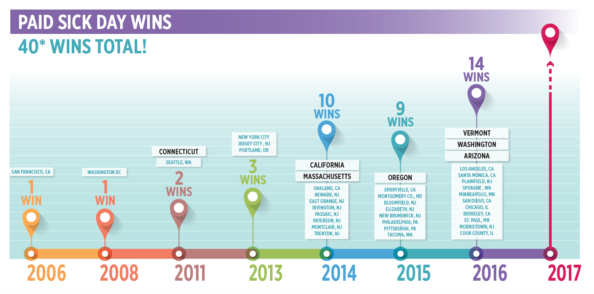What a difference a win makes – especially 40 of them.
Recent figures from the Bureau of Labor Statistics show a significant rise in the number of workers who’ve gained access to paid sick days over the past two years, the period when coalitions in our network and their partners achieved the highest number of victories. Today 68 percent of U.S. workers in the private sector – nearly 79 million people – earn paid sick days, an increase of 7 percentage points since 2015. The Northeast and West, where many of the successful campaigns have been waged, saw the most progress. While the numbers went up for all income groups and job categories, the largest gains were among workers whose pay puts them in the bottom 25 percent of wage-earners.
Behind the numbers are millions of workers like Jibril Wallace, a grocery store employee in Washington, DC, who used to have no choice but to go to work sick. For a long time she could get only part-time hours – and part-timers had to be out three days before being paid for any illness. “Your body is giving you a sign that you need to rest,” Jibril said. “But you’d just medicate yourself, go in and pray you’ll feel better. I had to support myself.” Losing eight hours of pay meant losing the amount to pay for before- and after-school child care for the week. After DC expanded its paid sick days in 2014, Jibril says ““It’s awesome to know you have that cushion, especially when you’re part time. Everybody gets sick, or has a parent or kid who’s sick. This really helps out.”
Jibril and her family aren’t the only ones who benefit from her paid sick days. So do all of us who come in contact with service workers like Jibril. So do employers, who experience lower turnover and higher productivity when workers have paid sick days. The entire community benefits when people have stronger families and greater economic security.
Still, nearly one-third of all workers in the U.S. don’t earn a single paid sick day, including more than half of those in the bottom quartile of wage-earners and 70 percent in the bottom tenth. Nearly two-thirds of part-time employees work without this time.
Andrea Valasquez in Michigan is among those low-wage workers. She wants to make sure her state is added to the wins category. As a restaurant worker, Andrea, who suffers from a rare, chronic disease, had to put off going to the doctor and wound up hospitalized for six days. “I lost my job, my house, my car, and drained my entire savings trying to pay for medical treatment I need,” she said. Now she’s part of a coalition led by Mothering Justice to win a paid sick days ballot initiative in 2018.
As our network prepares for more wins, we are proud to be paving the way toward a national standard, the Healthy Families Act. That bill, introduced by Sen. Patty Murray and Rep. Rosa DeLauro, would ensure private sector workers can earn up to seven paid sick days a year, without undermining any more robust policies made at the state and local level. The time can be used to care for a personal or family illness, or to seek shelter or take legal action after experiencing domestic or sexual abuse.
Activists are taking the BLS statistics to their Congressional representatives during the August recess with this message: We won’t stop until every person in the workforce is able to take the time they need to heal or care for a loved one without worrying about their paycheck or their job.
